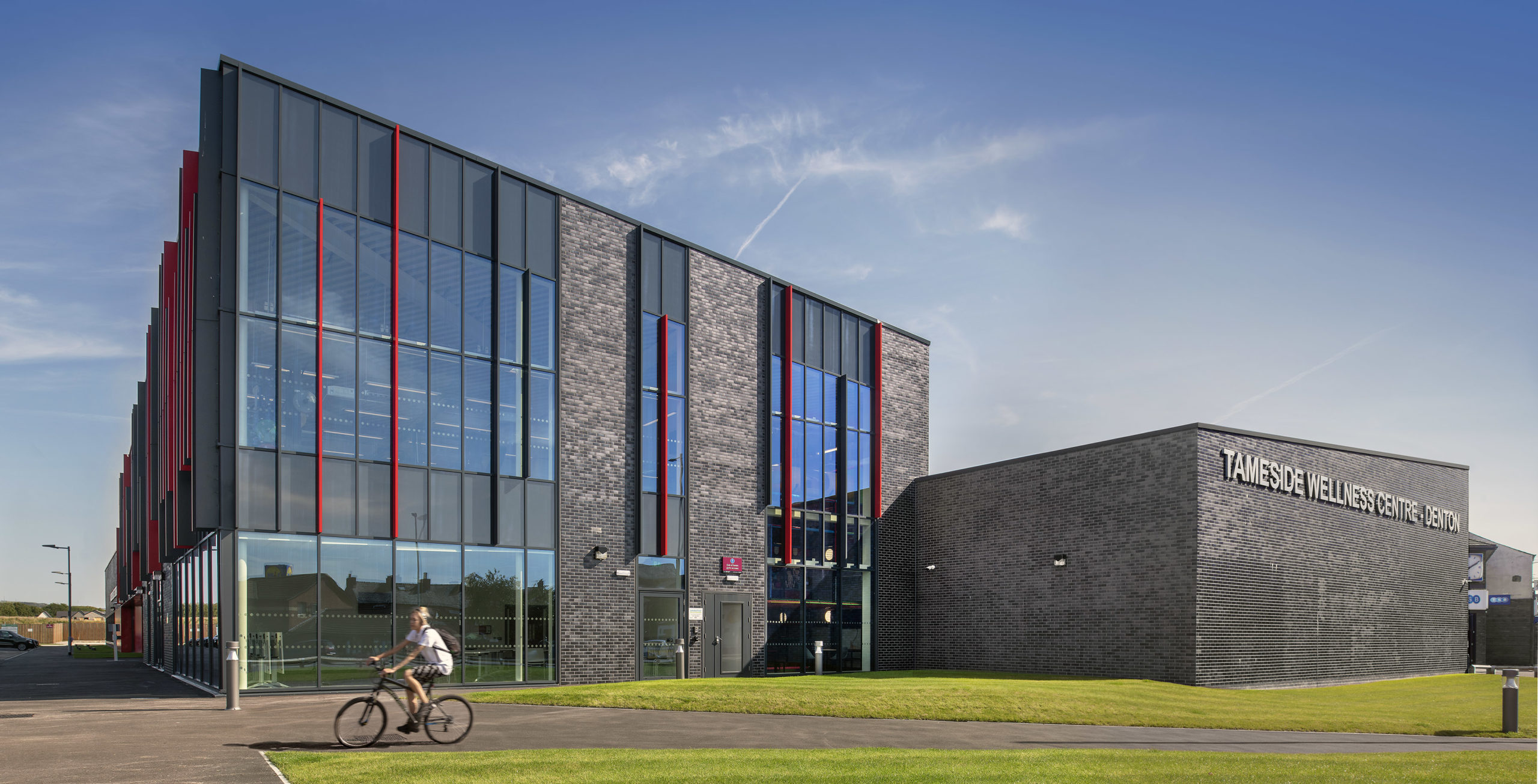Built on a JCT Design and Build Contract and completed ahead of schedule in March last year, the Tameside Wellness Centre in Denton, Greater Manchester, is the crowning glory of a 12-acre residential, retail, and health development to transform a local community.
The launch of the Tameside Wellness Centre in March 2020 was the culmination of a two-decade journey for Warrington-based developer, Network Space, to transform a derelict brownfield site and provide much needed regeneration – reinvigorating and giving a fresh identity to the local community of Denton. The Centre is a 45,000 sq ft conversion of a former battery manufacturing plant which takes a holistic and accessible approach to community welfare, combining a multitude of leisure, health and fitness, and wellness activities.
The Centre formed part of Tameside Borough Council’s review and replacement of their leisure offering and represents their largest new-build facility to date. The project was awarded funding by Sports England, who provided a grant of £1.5m.
The vision for the Centre was to deliver a space that focuses on public health whilst creating a sense of fun and community engagement with a variety of flexible, multi-use areas. It features an eight-lane, 25m swimming pool that includes space for 150 spectators and an accompanying learner pool. A spa area includes a sauna, steam room, and other treatment and relaxation facilities. The Centre’s fitness suite boasts a 50-station gym, two exercise studios and a spinning room.
In addition to its sports and relaxation facilities, the wellness features include flexible meeting rooms, free wi-fi throughout, a children’s soft play area, multi-use studio spaces, and a ten-lane ten-pin bowling alley. The 12,000 sq ft roof space has been transformed into a mixed-use terrace that functions as a sensory garden, and supports a pop-up cinema, small theatre shows and an open-air exercise space.
An innovative feature is the building’s ‘social interaction zone’, which does away with the need for a traditional foyer arrangement. A concierge-style approach replaces the reception desk to enable staff and visitors to interact in a more informal way. The wider space functions as a cultural hub that supports catering, a performance space to host anything from a music group to a talk, to children’s ‘Time for Rhyme’ sessions. There is also space for reading and relaxation.
Externally, the building carefully balances the need to be inspirational and present a scale befitting its civic function with a consideration of its local surroundings. The façade facing the high street uses strong forms and colours with traditional materials and large glazing to present a dynamic and welcoming entrance. To the rear where the building faces on to residential dwellings, the building has been massed to reflect this smaller scale.
The Centre’s design is closely linked to its function and goes beyond its aesthetic features. One important factor in the project brief was to ensure that accessibility for all users was a key consideration. Normal accessibility features such as ramps were discounted, with the view that if the design was done correctly at the outset, there would be no need for any accessibility features as ‘add-ons’, enabling the building to be used and enjoyed by all in a more organic way. As such, full access for wheelchair users to the pool area has been designed, along with a moving floor in the learning pool to ease access for disabled users. The layout and design of the development has also been implemented to be dementia-friendly.
One of the key factors behind the project’s early delivery was the expertise of contractor, Wilmott Dixon, and in particular, project manager, Jamie Beard, whose experience of swimming pool installations enabled a number of cost and time saving measures. Budget was redistributed to ensure that the waterproofing system was designed, installed, and warranted by the same contractor. This meant that no subsequent rectification of the pool slab waterproofing was required. Further efficiencies were implemented by using a prefabricated stainless steel structure imported from Italy, instead of building a traditional in-situ concrete tank for the pool. The super-large water balance tanks were positioned outside the building rather than under the pool surround which avoided a potentially difficult insertion operation. The pool slab depth was altered from 600mm to 225mm on top of piles, which not only saved costs and time, but reduced the amount of concrete and rebar required, and reduced potential risks on the waterproofing solution. Digital innovations, including virtual reality walkthroughs for stakeholders, helped the Centre to sell 800 memberships before opening.
In recognition of the Tameside Wellness Centre’s impact on the community of Denton, it was named a 2021 Civic Trust Awards Regional Finalist. Another hallmark of quality is the use of the JCT Design and Build Contract, which is the choice of many complex and large-scale projects, such as leisure facilities, where the contractor is responsible for the design and construction of the works. A widely used and regarded form such as the JCT Design and Build Contract provides a platform which enables the delivery of projects like Tameside to go swimmingly.
Project Data
Client: Network Space / Tameside Borough Council
Size: 4190sq.m. / 45,000sq.ft.
Contract: JCT Design and Build Contract
Cost: £15m, with £1.5m Sports England grant
Architect: Pozzoni Architects
Contractor: Wilmott Dixon
Quantity Surveyor: WCP Associates
Structural Engineer: WYG (White Young Green)
Cultural Ambassadors: Eley Kishimoto
Images: Pozzoni

